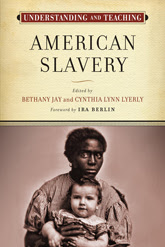
Essay 2: How to Teach Slavery
Recognizing that inaccurate history often subtly promotes continuing white supremacy, the National Education Association (NEA) commissioned these articles and has posted some of them in slightly different form at its website. I thank Harry Lawson and others at NEA for the commission, for editorial suggestions, and for other assistance.
To understand our country, Americans have to understand the role slavery has played. Understandably, the topic can make teachers nervous. But teachers who leave it out, cover it hastily, or soften its harshness inadvertently minimize its importance. This makes history white, not right.
Most textbooks now show the horror of slavery and its impact on black America. However, they remain largely silent about its impact on white America, North or South.
Slavery’s twin legacies to the present are the social and economic inferiority it conferred upon blacks and the cultural racism it impregnated within white minds and inside our culture. Both still haunt our society. Unlike slavery, racism is not over yet. Textbooks have trouble treating honestly any problem that has not already been solved.
The key insight students need is: racism arose in part as the rationale for slavery. (It also rationalized the taking of the land from indigenous peoples.) Montesquieu, the French social philosopher who had a deep influence on American democracy, summed up the role of racism ironically: “It is impossible for us to suppose these creatures [slaves] to be men, because, allowing them to be men, a suspicion would follow that we ourselves are not Christian.” Here Montesquieu is presaging Leon Festinger’s idea of cognitive dissonance — that people mold their ideas to rationalize their actions.
People are not born racist. Little babies have no idea that people come divided into different races. Indeed, biologically, there is only one race – the human race. History divided us up into races.
Slavery had existed long before racism, of course. Europeans enslaved each other, Africans each other, Native Americans each other. Previous slaveries hardly treated enslaved persons justly, but slaves sometimes did get traded back to their home people. Or they might eventually marry someone from the host society, thus escaping bondage. Around 1450, however, Europeans put together cannons, ships that could sail against the wind, and other social and physical inventions and proceeded down the coast of Africa with a newfound military superiority. The racial slavery that resulted offered almost no way out. Moreover, one’s children and their children were also enslaved forever. Such blatant injustice required stronger justification — hence racism. By the 1850s, most whites considered blacks so inferior that slavery was appropriate for them.
This view of African Americans was not just Southern and did not just go away in 1865, when slavery was outlawed. The very essence of what we have inherited from slavery is the idea that it is appropriate, even “natural,” for whites to be on top, blacks on the bottom.
The struggle over slavery and white supremacy is the dominant single theme in American history. Most antebellum mansions, North and South, were built by slaves or from profits derived from the slave and cotton trades. Black-white relations became the central issue in the Civil War, which killed as many Americans as all our other wars combined. The political and social contest between blacks and white supremacists was the main issue of Reconstruction. The Nadir of race relations (1890-1940) then led to the ongoing struggle for civil rights.
It is critical that students today understand all this. Unfortunately, I have yet to read a textbook that connects history to racism. Uninformed notions may rush in to fill the resulting analytic vacuum. White students may conclude that all societies have always been racist, perhaps by nature, so racism is all right. Black students may conclude that all whites have always been racist, perhaps by nature, so to be anti-white is all right. History is the antidote to these fallacies, beginning with an accurate portrayal of the relationship between slavery then and racism now.
Essential Reading
- Loewen, “Methods for Teaching Slavery to High School Students and College Undergraduates in the United States,” in Bethany Jay and Cynthia Lyerly, eds., Understanding and Teaching American Slavery (Madison: U of WI Press, 2016), 9-30, tells the four key problems enslaved persons faced and also suggests a metaconversation to hold with students to start a discussion of slavery.

All essays in the Correct(ed) series:
Introducing the Series
Essay 2: How to Teach Slavery
Essay 3: How to Teach Secession
Essay 4: Teaching about the Confederacy and Race Relations
Essay 5: Confederate Public History
Essay 6: Reconstruction
Essay 7: Getting History Right Can Decrease Racism Toward Mexican Americans
Essay 8: Problematic Words about Native Americans
Essay 9: How and When Did the First People Get Here?
Essay 10: The Pantheon of Explorers
Essay 11: Columbus Day
Essay 12: How Thanksgiving Helps Keep Us Ethnocentric
Essay 13: American Indians as Mascots
Essay 14: How to Teach the Nadir of Race Relations
Essay 15: Teaching the Civil Rights Movement
Essay 16: Getting Students Thinking about the Future